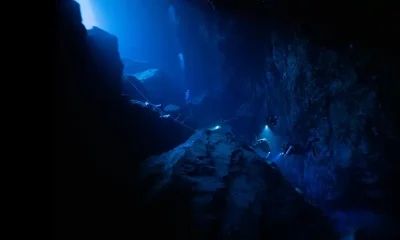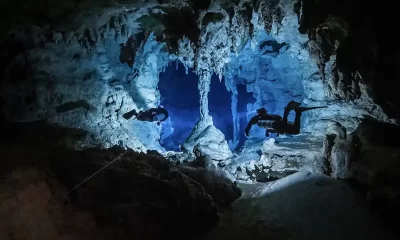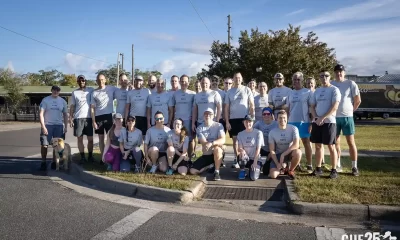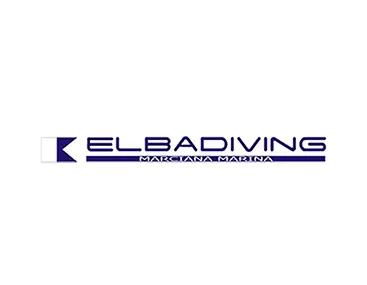Cave
In The Line of Duty: Surveying 12.7 km of New Cave Passage
You may think explorers are coming up empty handed after nearly 40 years of scooping booty in Maya Riviera cave systems. You’d be wrong. Explorers Bjarne Knudsen, Emőke Wagner and László Cseh, aka Team BEL, discovered and surveyed 12.7 km /41,600 ft of new underwater passageway, found a new cenote, two new connections, and a prehistoric bone site during the last 12 month season. Here’s how to go where no one has gone before!
by Bjarne Knudsen, Emőke Wagner and László Cseh, aka Team BEL. Note that Bel also means “path” in Mayan. Images courtesy of BEL unless noted.

Our first project last season (2021) started from a well-known cenote called Yax Chen at the southernmost corner of the Ox Bel Ha cave system. The prior year, we needed additional survey data from the region and, on a regular survey dive, we found the beginning of a new, potentially unexplored, area. Although it was close to another new recently discovered section of the cave called, “The Swampland,” we didn’t believe the two were connected, so they decided to wait for this season to proceed.
The project began by surveying existing lines on the downstream section of cenote Yax Chen. The most successful line was laid by early Yucatan pioneer Gary Walten in the downstream area after multiple restrictions and cenotes took a turn to the north and headed toward historic sections of Ox Bel Ha. After 1.6 km/5,250 ft of distance into the cave, his line ended in front of a massive collapse.
Observing the area, we were able to navigate between fallen boulders as noticeable flow was still present. After a while they managed to climb on top of a more open hill, which had a light source high up. It was a cenote; however, in addition to the opening being sidemount size, a piece of a fallen tree blocked the small exit. With some effort, the team was able to shift the tree slightly so that, after unloading all their gear, they were able to exit into the cenote. At this time, the visibility was crystal clear, and the plan was to drop back down into the cave on the other side of the seemingly small cenote. With further examination, it was determined that the cenote was not as small as previously thought, and it made more sense, instead
of another tight and silty squeeze, to follow the path of the water in the cenote. We did that and, as in some areas, had to cut our way through dense mangrove roots, the cenote descended back into the cave after 57 m/187 ft of distance.


Discovering “The Roots”
The small new opening had a line already very close to the cenote; we knew we had arrived at the desired historic section, and another connection between Yax Chen and Ox Bel Ha was made while discovering a new cenote that the team named “The Roots.” Later, this name was used for the entire new section. It is unknown why Gary or members of the Grupo Exploración Ox Bel Ha (GEO)* never traversed the cenote from either side of the cave; one likely reason could be the conditions—with heavy rainfall, the cenote and the entire region turns almost undiveable due to tannic conditions (as our BEL team soon learned).
New leads discovered in the historic section all pointed into a seemingly open area, which made future exploration very promising. Unfortunately, we had to pass through the new ‘sidemount’ restriction at the cenote on every dive in this area, since no other path was found around it from either side of the cave. This meant unclipping everything, putting it on the line, squeezing through, and then the other diver still inside the cave had to hand the gear piece-by-piece to the diver already in the cenote. After this, another squeeze was conducted by the second diver, followed by gearing up in the cenote.
As time progressed, we became better and more efficient with the process, but it was always tedious and time-consuming. On the other side of the restriction, the dive continued, and the goal was to head as far northeast as possible, since the cave seemed to be open in that direction. We had to navigate in small, low ceilinged areas, where the bottom was very densely filled with thick layers of black sediment. In this area at least, percolation was minimal.

After some dives towards the northeast, all of the small and irregular tunnels started to become even smaller, and eventually they stopped. Another complication in the area was the constant and intense rains we had during the summer of 2021. Because the Roots area was very shallow, the rain washed all the tannins into the majority of the tunnels and made visibility close to zero. With slow but determined progress, a more defined east tunnel started to form, but because of the bad conditions in the overhead, we had to delay our dives. The conditions did not improve, but the team was curious where the new east tunnel went. The problem with this tunnel was that it was quite small in its beginning, and a better route had to be established to push more comfortably toward the east. When we finally arrived at the above-mentioned area, the conditions were still bad, but we were determined to establish a new tunnel towards the east. Going from wall to wall we managed to lay a line through an area which was very dark, but bigger and, in the end, looped back to the east line. This allowed opportunities for future dives with more equipment.
Going to the Sea
After many months, the conditions improved slightly, and the team was back to finally check where the new east line went. Having a better route for travel, we arrived at the desired area in good time and kept pushing. Unfortunately, a few hundred meters past the end of the line we arrived at another sidemount restriction at about 2.3 km/7,540 ft of penetration. There was seemingly no other way around this one either.

Pushing through the restriction, the cave continued, but the team had to navigate collapsed and silty areas. The cave started to change slowly, and the bedrock became more solid. The cave opened up more regularly into huge rooms, and some of them had metal or PVC tubes in them, as we were traveling under a touristy area with lots of buildings. Loud noise, probably from large generators powering the hotels, could also be heard.
Checking the survey data at home, the new lines were headed toward the sea. This encouraged us to return to try to connect this part of the system to the sea. Unfortunately, this never happened, as the closest we got was 50 m/164 ft. Flow was present, but the cracks in the wall became too small to pass, and the tunnels turned more parallel to the shore than perpendicular. After this area had been checked thoroughly, the team wrapped up remaining leads and we were lucky enough to connect almost all of the newly discovered lines into one survey, which established the section called The Roots with 5.8 km/19,000 ft of new tunnels. The total exploration in the area was 6 km/19,700 ft, with a maximum penetration distance from Yax Chen of 3 km/9,800 ft. Average depth was 6.5 m/21ft, maximum depth was 12.6 m/41 ft. We were using the Global Underwater Explorers (GUE) sidemount configuration with multiple stages and SUEX diver propulsion vehicles (DPVs).

The Cave East of Coka Ha
After the exploration in Yax Chen, it was time for the team to switch the scenery and focus their efforts for a while in other places. The 2019 exploration from Cenote Chuup Ich and Coka Ha resulted in new data, but some distant areas of the cave there were left unchecked. One of the most interesting parts of the area was a very defined, long, open tunnel heading straight toward the east from cenote Coka Ha. At the time, we were not able to fully explore the region due to landowner restrictions, but some possible leads made this place worth revisiting one more time. With enough preparation and planning, we had no choice but to prepare for regular, long distance dives, as access to closer cenotes was not available.
From Cenote Chuup Ich, the end of line from 2019 lay at a distance of 4.1 km/13,400 ft. Most of the trip was comfortable, but the cave was very dark there, had a lot of sediment, percolation, and complex navigation. As the dives to this area became more frequent, the team also increased its capacity to deal with the longer travel more efficiently; the shortest and easiest path was fully overhead, as it avoided any nearby cenotes, but at 3.6 km/11,800 ft of penetration, a major restriction was encountered.


A bypass tunnel was found quickly, which made that part a bit easier to navigate. We also built and tested special batteries for our scooters, which made those dives possible with minimal gear load. When we reached the furthest lead for the first time, instead of following the line out into the two relatively new cenotes that we found in 2019, we took a northeast turn and tried to bypass the openings. There, the cave dropped slightly deeper, became smaller, and was even siltier.
After a short distance of irregular tunnels, the cave opened back up again into its original size and continued due east. The cave was highly decorated with formations, had some small collapses on the sides of the main tunnel, and remained dark in color. After a few hundred meters, the passage hit a high, silty slope which had organic sediment. As we swam up to the top, a small dry cave with a little opening was observed while bats were flying inside it. Because of this, we named it the “Bat Cave” for future reference. There didn’t seem to be any obvious way to continue past the bat cave.
On a subsequent dive, we tried to find a way to bypass the Bat Cave area. The northeast side of the slope seemed to be a possibility if we dropped deeper. A smaller tunnel with heavy percolation allowed us to progress further. There the cave started to branch into more directions, but identifying the proper lead to move on was difficult as the low ceiling allowed us only moments of time to look around because sediment from the ceiling completely destroyed the visibility in seconds. After a few trials, it seemed the cave would head northeast rather than east, which seemingly could have been even better, as the north was in a fully open region. Unfortunately, as we tried to push from here, the cave either ended in collapse or became smaller and died. This part of the cave also never turned back to the south to continue in the original east direction again behind the bat cave. Finally, toward the end, other, smaller leads were finished, and the team managed to explore 3.2 km/10,500 ft of new cave in this area. Their furthest point of penetration was close to 5 km/16,400 ft and, depending on the environment, the team used both (open circuit) backmount and sidemount configurations with multiple stages and the DPVs. Average depth was 11 m/36 ft, maximum depth was 19.5 m/64 feet.
Moving to The Bees
As the new year of 2022 unfolded, we hoped to complete one last small project following our exploration of Coka Ha. Fortunately, we received additional help from Dr. Mario Vallotta, who was interested in surveying a cave called Abejas, or “The Bees” in Spanish. The cave was last explored extensively in 2004 and belongs to the giant Sac Actun cave system.
As usual, with Mario’s help, we started our survey of existing lines from the cave entrance. On a regular survey dive, we found a few hundred meters of new tunnel close to the entrance. Analyzing the data back home, it appeared that this new tunnel created a big shortcut for divers wanting to travel to the northeast. The size of the tunnel also allowed equipment to be carried through it.
As a result of finding the shortcut tunnel, our new goal became traveling further to the northeast to look around in that area, which hadn’t been visited much or at all in many years. As we kept surveying towards the north, we found more bypass tunnels along the way, which further decreased travel time and increased our efficiency. One of these new lines created the second connection between Abejas and the northeast area of Sac Aktun. The first open areas after this had good possibilities to the west, where the cave seemingly opened up. Unfortunately, all the leads in this initial area dropped quickly down into the halocline, where the small saltwater tunnels quickly ended. The freshwater sections of this cave were white, but these saltwater tunnels had black walls.
As the distance increased, we relied on our DPVs, and cave diver Cameron Miller joined us in exploring further upstream. Fortunately, we got lucky following the north lines and always keeping an eye open for possibilities to the west. Around 2 km/6,600 ft upstream from the original entrance, there was a low ceilinged area laying northwest that opened up into a bigger more defined tunnel with good conditions—a lot of sediment was present on the floor, but percolation from the ceiling was minimal.

Finally, after another major restriction, the cave took a hard turn to the west and kept going in that direction for quite some distance. That part of the cave had bigger rooms with cave formations and still contained fresh water with mild flow, which was a good sign. After a few hundred meters, more restrictions had to be navigated and the conditions worsened. On the other side of the new small and silty section, small areas of the cave began to collapse more frequently. One of the collapses revealed an area with animal bone remains. Judging by their characteristics they must have belonged to different types of animals and they were most likely prehistoric.

Past the collapsed section, the cave descended back into the saltwater layer. Slowly, after some branched tunnels, all the passages became progressively smaller and were impassable to the west and to the north. After checking the final leads, this new small section had 2.4 km/7,800 ft of new tunnels, bringing this entire project’s new exploration distance to 3.5 km/11,500 ft, with many kilometers of resurveyed old line. Maximum penetration distance was 3 km/9,800 ft. Average depth was 9 m/30 ft, maximum depth was 13.3 m/43 ft. We used backmount, along with stages and scooters for this portion of the exploration.

More To be Found
Needless to say, our BEL team had a good last year in terms of finding new cave passages in some of the largest cave systems in the world. In addition to many kilometers of resurveying of existing lines, the team managed to discover 12.7 km/41,600 ft of new tunnels, one new cenote, two new connections, and one prehistoric bone site. Their dive times averaged between six and eight hours. Efforts like these show that even after many years of great cave explorations, Mexican caves still hide some fascinating surprises and possibilities for interested and committed divers.
This was also the first time we tried to incorporate some more divers into the projects and put their skills to good use! Many thanks to Mario and Cameron for their support. Lastly, huge thanks go to the Cuzel Filling Station who supports our dives with tanks, standard gasses, excellent logistics, and their availability even in the evenings at the end of our long exploration days!
Footnotes:* Grupo Exploración Ox Bel Ha: a legacy cave exploration group that consisted of the late Bil Philips, Steve Boagerts, Chris Le Maillot, Daniel Riordan, Bern Birnbach and more.
This month we’re launching a survey panel on dive computing. Please help us by sharing your thoughts & practice at: Dive Computers-Exploratory Survey.
Dive Deeper
InDEPTH: Laying Line in Ox Bel Ha By Emőke Wagner, László Cseh and Bjarne Knudsen
InDEPTH: Data for Divers: Mexican Explorers Go Digital to Chart Riviera Maya by Michael MendunoWebsite/Blog: Emőke Wagner and Laszlo Cseh GUE Instructors

Bjarne Knudsen began diving in 1993, taking his first tech classes in 1997 and his first GUE Cave and Tech classes in 1999, so has been part of the GUE community since the early days. In the early 2000s he spent some years in Florida, where he was a part of the WKPP. During this time, he also pushed Sheck Exley’s end of line in the Cathedral Cave system with Todd Leonard (and lots of support from friends). Bjarne is currently on a slow world cruise with his wife on their sailboat. For the last few years, they’ve been a little stuck in Mexico and the surrounding countries, which offer so much nice diving.

Emőke Wagner is originally from Hungary and began diving at a young age. She has been an active instructor since 2014. After a couple of years spent traveling around the globe, she moved to Mexico with her husband in 2017. While living in Mexico, cave diving became her real passion, and she began exploring more of the local cave systems. Since 2016, Emőke has been working as a full-time GUE instructor and is currently teaching the cave, foundational, and recreational curriculum.

László Cseh is from Hungary and has always been fascinated with the underwater world. He became a recreational diving instructor in 2012 and began teaching and traveling with his wife, Emőke. After becoming a GUE instructor in 2016, he moved to Mexico to look for new diving challenges. Local cave exploration possibilities helped him achieve his GUE Cave instructor certification.



















































